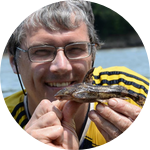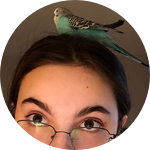Project Results
I found that northern Rock Pigeon populations had a heavier body mass, longer wing chord, and longer head length than their southern counterparts. This geographic variation in phenotypes observed in feral Rock Pigeons in the eastern United States suggests this species may be poised to respond to local selective pressures.
About This Project
This study aims to better understand how birds can micro-evolve in a newly colonized environment. I hypothesize that over the last 200 years, pigeons in eastern North America have evolved diversity of morphometric and color based characteristics. To test this hypothesis I will collect data on morphometric and color-based traits in wild pigeons at different geographical sites in eastern North America.
Ask the Scientists
Join The DiscussionWhat is the context of this research?
The rock dove or Columba livia, more commonly called the "pigeon" is native to much of the "old world". Pigeons have been introduced in to much of the world, including North America. Newly colonized environments are often very different from native ranges, so birds must adapt. Birds in captivity show radical phenotypes from reduced beaks, feathers growing from their legs and fanned tails. Don't believe me? check it out!. This variation has occurred in a relatively short time, rock doves have only been domesticated for 5,000 years as opposed to 15,000 years for dogs who show similar variation. While wild rock doves show none of these extreme features, these captive traits demonstrate amazing possible variation in the wild.
What is the significance of this project?
Many species have fragmented ranges that have been created by human destruction of wilderness. It is known that range fragmentation affects population, but how? Rock doves make an excellent model organism for evolution and have been used since the time of Darwin for this purpose. Rock doves have been introduced to various environments in North America that are very different from their native range in climate, habitat and available resources. Seeing how rock doves have adjusted to different environments over their approximately 200 year stay in North America will hopefully shine a light on how wildlife in general can adapt. It may also teach us a little more about the life history of an often overlooked species.
What are the goals of the project?
My hypothesis is that over the last 200 years, pigeons in eastern North America have evolved diversity of morphometric and color based characteristics. To test this hypothesis I will collect data on morphometric and color-based traits in wild pigeons at different sites in eastern North America.To test this hypothesis I will collect data on coloration and morphometrics. To collect the data I will travel the following study sites: Crane Point, Marathon Key FL Green-wood Cemetery, Brooklyn, NY, Patterson Park, Baltimore, MD, Charleston, SC (site currently unknown, and South Boston Beaches, Boston, MA. At each site I will be trapping pigeons and collecting data. The data will help me figure out if and how rock doves are evolving.
Budget
The use of a bow-net trap, though expensive, is necessary for this study. A bow net works by luring birds into an area then quickly snapping a net on top of them. This is the safest and most efficient way to trap wild rock doves and it will allow for the monitoring of birds caught to ensure no native (protected) birds are caught by accident. See one in action!
The majority of the rest of the equipment is safety and precautionary equipment. Some of it, like the animal carrier and food and water dishes are for the long-term (longer than 1hr) holding of sick, injured or domestic birds. Signs and flagging are to keep the public from disturbing the experimental set-up and possibly harming themselves or captured birds (I don't know how this would happen, but I like to be careful).
Bait and calipers are integral parts of the study's procedure while other costs are un-avoidable for this type of work.
Endorsed by
 Project Timeline
Project Timeline
My timeline is still rather fluid as of now. This will be updated as I get closer to my collection dates.
May 08, 2019
Project Launched
Jun 01, 2019
June 2019, start collection
Aug 31, 2019
August 2019, end summer field season
Sep 01, 2019
September 2019, begin to compile data and share initial results.
Jan 01, 2020
Winter-spring break 2019-2020, finish collection.
Meet the Team
Sarah Rackowski
HI!
I'm Sarah Rackowski, high school junior and resident bird nerd. this project is my first field study and second independent research project, so any help with funding would mean a lot to me!
My past scientific experince includes working at the Academy of Natural Sciences in Philadelphia in both the ornithology department looking at how the behavior of owls affects their feather structure See the report here!. As well as in the ichthyology department investigating a possible new species of corydoras catfish. I am also working with various pigeon-keeping clubs for instruction on how to properly work with rock doves for my research.
The bird on my head is turquoise the "desk budgie". Chances are, if I'm working on this webpage, my buddy turquoise is sitting on my desk (or on me!) giving his input on my work.
Being able to work on this project would be a major step forward in my career as a researcher and scientist.
Thank you for your support!
Additional Information
Summary:
Rock doves are evolutionarily fascinating animals, having diverged into twelve subspecies in the wild and show many diverse phenotypes in captivity. Understanding how rock doves adapt to different environments will not only tell us how birds as a whole are able to survive in a changing world but also give us insight into the incredible yet all too often overlooked bird perching on our window sills.
Collection site map as of May 17th:
1, Freeport Maine
2, Boston Massachusetts
3, Brooklyn New York*
4, Cape May New Jersey*
5, Washington D.C*
6-7, Charleston, South Carolina
8, Marathon key, Florida*
Starred locations are those that are still pending approval (permits/permissions) however, these sites will most likely be approved soon.
Works Cited
(6)Andrén, Henrik, and Henrik Andren. “Effects of Habitat Fragmentation on Birds and Mammals in Landscapes with Different Proportions of Suitable Habitat: A Review.” Oikos, vol. 71, no. 3, 1994, p. 355., doi:10.2307/3545823.
(4) Blechman, Andrew D. Pigeons: the Fascinating Saga of the World's Most Revered and Reviled Bird. University of Queensland Press, 2007.
(7) DARWIN, CHARLES. ON THE ORIGIN OF SPECIES. ALMA CLASSICS, 2019.
(2) Gibbs, David, and Eustace Barnes. Pigeons and Doves: a Guide to the Pigeons and Doves of the World. Pica, 2001.
(4) Irving-Pease, Evan K., et al. “Paleogenomics of Animal Domestication.” Population Genomics Paleogenomics, 2018, pp. 225–272., doi:10.1007/13836_2018_55.
(1) “Rock Doves.” Columba Livia (Common Pigeon, Rock Dove, Rock Dove, Rock Dove), oldredlist.iucnredlist.org/details/22690066/0.
(5)Schorger, A. W. “Introduction of the Domestic Pigeon.” The Auk, vol. 69, no. 4, 1952, pp. 462–463., doi:10.2307/4081033.
(3) Stringham, Sydney A., et al. “Divergence, Convergence, and the Ancestry of Feral Populations in the Domestic Rock Pigeon.” Current Biology, vol. 22, no. 4, 2012, pp. 302–308., doi:10.1016/j.cub.2011.12.045.
Project Backers
- 18Backers
- 124%Funded
- $1,167Total Donations
- $64.83Average Donation

